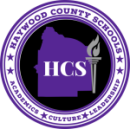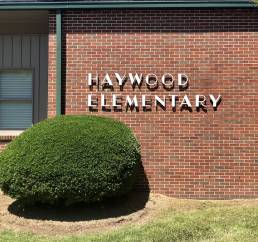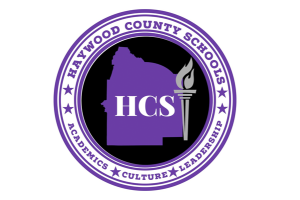HES – Academic Focus
The foundation for a successful future in education often begins in early elementary school. Beyond making sure students have a fundamental understanding and grade level mastery of necessary academic skills such as reading and math, teachers also need to make sure that students are learning appropriate social behaviors and positively adjusting to the Monday through Friday schedule that will be part of their lives beyond graduation.
Like many schools in Haywood County Schools, Haywood Elementary School not only teaches the fundamentals of academics, but also mixes useful life skills practices into students’ daily schedules. Using curriculum from The Leader in Me, HES students learn how to prioritize their learning as well as take ownership of their learning. While that may sound like an arduous task for a First or Second grade student, these positive habits are woven into the culture at HES.
HES Instructional Facilitator, Chelsea Currie, believes that the learning that takes place among the students at HES can be directly connected to and supplemented by The Leader in Me curriculum.
“We’re a big Leader in Me school, but the most direct way the TLIM model contributes to the academics at HES is the way it encourages students to be responsible for their own learning,” she explained. “In the end, the teachers can teach in the most effective ways possible, but if a student doesn’t take responsibility for their own learning that learning will never occur.”
Like another principle in the TLIM, HES teachers begin with the end in mind and that end goal is student learning. But how do they get to that end goal? What’s the starting point? A good place to start is the data.
In many ways, data collected in schools from benchmark tests is like a road map to a destination. While the data may not give a teacher a straight line to exact instruction, it can definitely help teachers plot a course that ends with each student receiving the most individualized learning plan possible. The collection of that data starts almost as soon as the school year stars.
“We’re using our benchmark data to make sure we’re laser-focused in teaching our students,” Chelsea said. “Once the data is collected, we review it and look at it by grade level and classroom. We really want to individualize instruction based on students’ needs.”
One program that has greatly aided HES in the individualized instruction process is The Reader/Writer Project (RWP). The RWP uses student data in reading to place students in individual micro-phases based on the student’s personal reading journey and where they are along their reading path. Each day there is a 45 minute block of time carved out for RWP intervention. During this time, students receive intensive, individualized reading instruction based on their current reading level.
“The Reader/Writer Project is unique in the way it’s laser-focused on where a student is on their reading journey. Students are split into micro-phases based on their data and get individualized support in reading based on where they are,” Chelsea said. “The RWP is implemented every single day. We have three adults in every classroom during that part of the day. I’m part of it, too. I go into a second grade classroom every day for 45 minutes.”
The RWP was implemented in early elementary schools (Anderson and HES) in 2019, but was interrupted due to COVID-19. Last year was the first full year of RWP implementation at HES. With a full year under their belt, Chelsea is confident that the RWP will only improve student outcomes during this school year.
“Last year was the first full year of RWP. It was implemented just before the pandemic, but was interrupted due to COVID. Now, after having a full year under our belt, we’re excited to see how the RWP will help our students this year,” she explained.
Chelsea’s role as Instructional Facilitator at HES is to support student learning by helping teachers purposefully use data in their instruction, offer teachers real-time coaching in instruction, and make sure students are engaged in the learning process. As part of the leadership team, Chelsea will take part in classroom walk-throughs and wants to see learning taking place even if those ways aren’t necessarily the same in every classroom.
“We’re definitely looking for students actively learning. We’re looking for student engagement – with the teacher, with each other, and in a productive way,” she said. “Teaching now is a combination of active teaching and facilitating. It’s important for teachers to allow students to have some ownership over their learning. A lot of student learning comes from conversing and talking with other students.”
Like all educators, Chelsea knows the work being done in the classrooms is important, but that work is also finite if it isn’t being supported at home. Parents and families play an integral role in the partnership of education. At an early age, students need to be read aloud to consistently; students need to converse with adults and have a way to process and synthesize the learning that took place during the school day.
“It is extremely important that parents read to their children at home,” Chelsea said. “We send things home for parents to use with their kids. We encourage our parents to use our Family Resource Center which is right here at HES. The more parents are involved in their child’s education at this age, the better.”
As far as the focus for this year, Chelsea just wants to see the good work at HES continue.
“We really want to sharpen the work we did last year. We want to meet students where they are in their learning and move them forward.”


